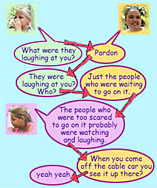
Text types: Texts for social interaction
| Overview |  |
The language of spoken interaction is different from the language we use when we write. Written texts are usually constructed with sentences and paragraphs which we draft and redraft in order to make them achieve the purpose of the text in the most effective way possible. Only then is a written text given to readers.

|
When we speak we do not use neat, carefully drafted sentences and paragraphs.
Although we use words organised in clauses, we choose
the words and construct the clauses spontaneously while our
listeners are listening. As we take turns to keep the interaction going, we don't always speak in complete clauses and sentences but hesitate, interrupt, pause and repeat things. Sometimes we don't finish our turn or we talk at the same time as another person. For these reasons, when we speak, we often do the following:
|
Shortened words
Sometimes we shorten a word by not finishing it, for example shortening yes to yeah.
We also shorten words by contracting two words into one. In contractions
an apostrophe is used to show that some letters are missing, eg contracting
he will to he'll. ![]()
Clause fragments
We often shorten clauses in a spoken interaction to fit in with the turn-taking
pattern and to keep the interaction moving forward. For this reason there are
many clause fragments in spoken interactions.
![]()
Sometimes we use clause fragments that leave out everything except the information which is the focus of the clause. Here is an example from a children's conversation where the second speaker uses a sentence fragment (lots of things) to answer the first speaker's question:
So what are you doing today? 
um ... [I'm doing] lots of things.
Sometimes we use a clause fragment which leaves out everything except the part which tells us whether the clause is asking for or giving information. In the example below, the second child repeats the beginning of the first child's question (have you) in order to bounce the question back again, ie to ask her the same question:
Have you been on the new ride? Well no. Have you [been on the new ride]?
When we speak, we also start clauses and then abandon them, changing our minds about what we want to say as we talk. Often when this happens another person takes a turn to help us finish what we are trying to say:
What you do is you're like ... there's like this ... um ... there's this ... it's really big, the place where it's at ... ... and it's so high.
Sometimes when we take a turn, we signal the topic of our next clause in a clause fragment (usually a noun group) and then start the clause all over again:
Me and my friend ... We were sitting up the top ...
Fillers
When we speak, we also use fillers to give us time to think as we
talk. We often combine these with connectives such as and, then, so,
but,
like. ![]()
Sometimes speakers repeat what they have said as a filler while they think.
Common fillers include:
ah like well er oh yeah I mean um you know
Here is an example of fillers in a conversation:

... and then you have to queue up in this really big kind of square thing ... it's ... like you know ... you have queues?
When people are listening to a speaker in a social interaction, they usually use different kinds of fillers to show the speaker that they are listening and that they understand what is being said. We call this backchanelling. In spoken interactions in English, speakers often say any of the following, or a combination, to show the speaker that they are listening and that they understand:
ah oh uh hm I see really? yeah mm right
Reactions
During social interactions we often react to what other people say by expressing our feelings or
evaluating something. Our reactions may be physical ones, for example people smiling, laughing, frowning, making a gestures of surprise or
excitement with their hands. However, they are often exclamations
(What an idiot! How awful!) or formulaic expressions (Wow!), and
sometimes taboo
words (Damn!). ![]()
Reactions can show various emotions:
 |
show support, eg exactly!, that's right, I know |
 |
add a comment, eg cool, fantastic!, that's great |
 |
vary the intensity, eg wow!, how awful, that's really amazing |
Here are some examples:
Sometimes our reactions to things initiate the next stage of an interaction. In this example one of the children reacts to some food she is eating. This initiates another reaction from her sister:

Oooah my crisps are too spicy! Naomi! Yeah? I told you not to get them, didn't I?
|
||
To give us feedback about this section, click here or on the Comment button at the top of the screen.
If you have any questions about this section, visit the Language Corner.
If you have any questions or suggestions about how to teach this section, send a message to the Teaching Corner.